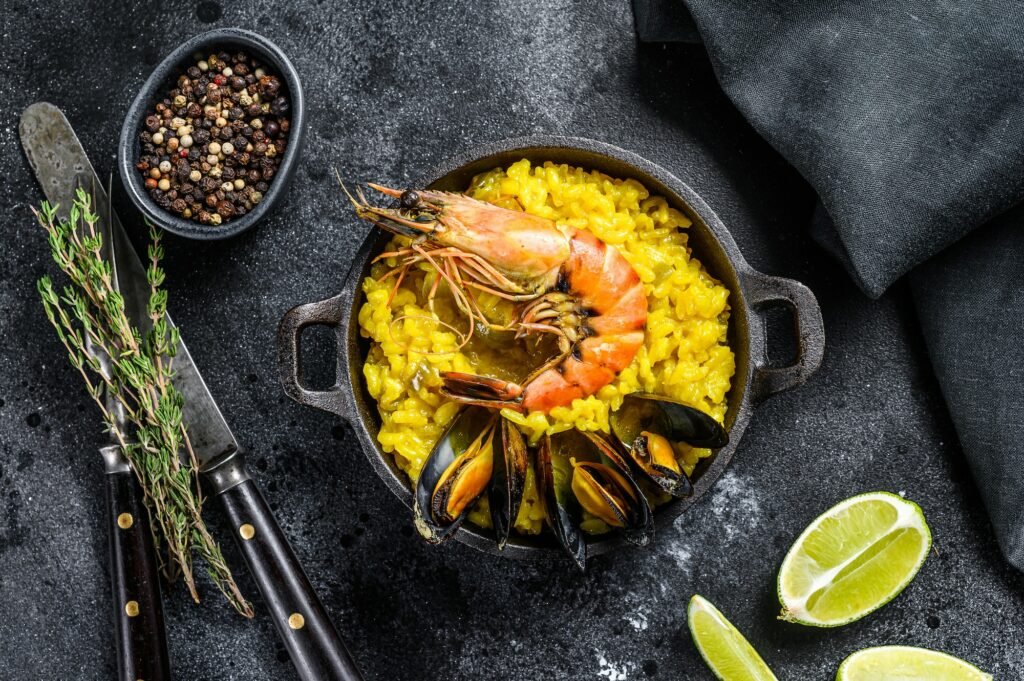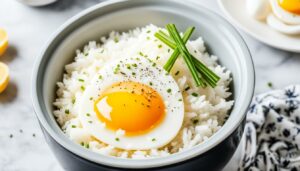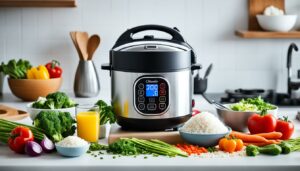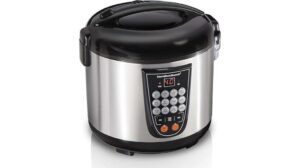Table of Contents
The Brief History of Paella
Paella is a traditional Spanish dish that originated in the Valencia region. It is typically made with short-grain rice, saffron, paprika, and an assortment of meats and vegetables. The dish has been around for centuries and has become a staple in Spanish cuisine.
In fact, paella is so beloved that it even has its own national holiday in Spain! Paella was originally cooked outdoors over an open flame using a wide, shallow pan called a paellera.
The dish was traditionally made with rabbit and chicken, but as it grew in popularity, different variations emerged using seafood or vegetarian options. Today, paella is considered one of the most popular dishes in Spain and around the world.
Why Use a Rice Cooker for Cooking Paella?
Traditionally, cooking paella can be quite challenging because it requires precise temperature control and timing to ensure that all ingredients are cooked evenly without overcooking the rice. Using a rice cooker takes away much of this complexity by automating the cooking process to ensure that your paella turns out perfectly every time.
In addition to ease of use, using a rice cooker also ensures consistent results from batch to batch since you can set the same temperature and cooking time each time you make paella. Plus, you don’t need any specialized equipment like a special pan or burner – just your trusty rice cooker!
Ingredients
List of ingredients needed for paella in a rice cooker
When it comes to making paella, using high-quality ingredients is crucial. The following is a list of the basic ingredients needed to make traditional Spanish paella in a rice cooker:
- Short-grain rice – Saffron threads
- Olive oil – Garlic cloves
- Chopped onion – Chopped bell pepper
- Canned diced tomatoes – Chicken broth
- Chicken breasts or thighs cut into small pieces – Spanish chorizo sausage sliced into rounds
- Shrimp or any other seafood (optional) – Frozen peas
It’s important to use short-grain rice when making paella because it absorbs liquid much better than long-grain rice. This results in a creamier and more flavorful dish.
The type of saffron used will also have an impact on the taste and aroma of the dish. Look for saffron threads that are deep red in color and have a strong floral scent.
Where to buy quality ingredients
Creating the perfect paella is not only about following the right recipe but also using the best quality ingredients. High-quality ingredients can make a significant difference in the flavor and aroma of your dish. Let’s explore some options for sourcing these ingredients.
If you are lucky enough to have a local specialty store that carries Spanish products such as La Tienda or Despaña, it’s definitely worth a visit. These stores offer a wide variety of authentic Spanish ingredients like saffron, chorizo, and paella rice. In fact, these products are often imported directly from Spain, ensuring that they are of the highest quality.
Alternatively, you can order ingredients online from reputable retailers such as Amazon or Gustiamo. These online stores specialize in sourcing hard-to-find gourmet foods from around the world, and they have a wide selection of authentic Spanish ingredients. Not only do they offer convenience, but they also provide access to high-quality products that may not be available in your local area.
For the freshest ingredients possible, consider visiting local farmers’ markets. Here, you can find fresh bell peppers, onions, and other produce that will enhance the flavor of your paella. Not only does shopping at farmers’ markets support local businesses, but it also allows you to connect with the community and learn about the origin of the ingredients you are using.
When it comes to using high-quality ingredients, it’s not just about taste, but also authenticity. By sourcing ingredients from trusted sources, you can ensure that you are creating an authentic Spanish dish. Plus, using fresh and high-quality ingredients will make your paella more flavorful and delicious.
For instance, did you know that the type of saffron used in your paella can make a significant difference in its taste? Look for deep red saffron threads with a strong floral scent to enhance the aroma and flavor of your dish.
Preparation
Before starting to cook your paella in a rice cooker, it is important to properly prepare all of the ingredients. The key to making a delicious paella is using fresh and high-quality ingredients.
For the rice, I highly recommend using short-grain Spanish rice varieties such as Bomba or Calasparra. They absorb more flavor and have a firmer texture, making them perfect for paella. As for proteins, I personally love adding seafood such as shrimp, clams, and mussels towards the end of the cooking process. It adds a delicious and fresh taste to the dish.
Clean and prep all ingredients before cooking. Thoroughly clean any seafood and remove shells or debris from the meat.
Cut vegetables into small pieces so they cook evenly with the rice. Prepping your ingredients ahead of time will make the cooking process smoother and less stressful.
Tips on how to properly clean and season the rice cooker
To get perfectly cooked rice every time in your rice cooker when making Paella In A Rice Cooker you need to make sure that it is clean and seasoned properly before use. Begin by removing any dust or debris from inside the lid with warm water then rinse it off until no residue remains- allow it dry completely before returning it back on top of your pot again!.
Next up is seasoning: add 1 tablespoon each of olive oil & salt into 2 cups (or more) water; then stir until dissolved well into solution; now pour this mixture carefully over top surface inside pot while avoiding direct contact with heating element/bottom area if possible – distribute evenly throughout sides too! As for cleaning your pot between uses (and preventing food from sticking), a quick wipe with a soft sponge and soapy water will do the trick.
Avoid using harsh chemicals or abrasive cleaning tools that can damage the non-stick coating of your rice cooker. With proper ingredient preparation and rice cooker seasoning, you’ll be well on your way to making a perfect paella in no time!
Cooking Process
Step-by-step instructions on how to cook paella in a rice cooker
Now that we’ve covered the ingredients and preparation, let’s move on to the actual cooking process. First, plug in your rice cooker and turn it on.
Some models may have different settings for different types of rice, but you’ll want to select the “white rice” or “regular” setting for paella. Next, add in your prepped ingredients into the rice cooker.
Begin by layering the chicken (or other meat) at the bottom of the pot. Over this, add in garlic cloves and sliced onions before adding chopped bell peppers and tomatoes.
Once your vegetables are layered well, add in your spices including paprika, saffron threads, cumin, salt and pepper. Gently stir these until everything is well mixed together.
measure out 1 1/2 cups of Arborio or bomba rice directly onto your vegetable-spice mixture. Add 3 cups of chicken stock or water into this mixture before stirring it one last time.
Tips on how to adjust the cooking time and temperature based on the type of rice cooker used
The cooking time and temperature can affect how well your paella turns out. Most standard machines will take around 20-25 minutes for white or brown Arborio rice varieties, while other models may require up to an hour depending on their strength. While cooking times do vary between different machines, you can generally tell when your paella is cooked by checking if all liquid has been absorbed into your dish; at which point you can turn off the heat and let it rest for around five minutes before serving.
Adjustments may be needed if using a smaller/larger machine than what was recommended. For small machines cut down recipe proportions by half while larger machines may require upping them by a quarter.
It’s always best to check the individual instructions of your machine to avoid any issues. Learning how to cook paella in your rice cooker may take some practice but after a few tries you’ll find it can be one of the easiest dishes to make with little time or effort involved!
Serving Suggestions
How to Serve and Garnish Paella
Now that you’ve cooked the perfect paella in your rice cooker, it’s time to serve it up! The traditional way to present paella is by serving it in the pan (or rice cooker, in this case) itself.
This adds a rustic feel to your table setting and allows everyone to grab a spoonful of the delicious saffron-infused dish. For garnishing, sprinkle some fresh parsley or cilantro on top of the paella.
You can also add lemon wedges on the side for those who prefer a tangy twist. Another great option is to add roasted red peppers, which not only give a pop of color but also complement the flavors of the dish.
Recommended Side Dishes and Drinks That Complement Paella
Paella is such a versatile dish that pairs well with many different types of sides and drinks. One popular option is a simple green salad with a light vinaigrette dressing, which helps cut through the richness of the paella.
Another great side is garlic bread or crusty bread dipped in olive oil and balsamic vinegar. This adds another layer of texture and flavor to your meal.
To drink, there are many options that pair nicely with paella. The most classic choice would be sangria – either red or white depending on your preference – which complements both meat-based and seafood-based paellas.
If you’re looking for something non-alcoholic, try an agua fresca made from fresh fruits like watermelon or pineapple – its sweetness balances out the saltiness of paella perfectly. Serving up your delicious rice-cooker-made paella doesn’t have to be complicated!
Simple garnishes like fresh herbs or lemon wedges can add an elegant touch while side dishes like green salads or garlic bread can complement the meal perfectly. And of course, don’t forget to pair your paella with a refreshing drink like sangria or agua fresca!
Variations: Exploring the Many Types of Paella
When it comes to paella, there are no limits to what you can experiment with. From classic seafood and meat varieties to vegetarian twists, the possibilities for adapting this dish are endless. If you’re looking for something new and exciting, consider trying one of these variations.
Seafood Paella

Seafood paella is a classic that never goes out of style. Made with prawns, mussels, clams, and squid in addition to vegetables like tomatoes, peppers, and onions. To make this dish extra special choose quality seafood such as clams from Maine or a few slices of octopus tentacles from Spain.
Vegetarian Paella
For those following a vegetarian diet or just looking for a meatless meal option: try making your own version using fresh vegetables such as broccoli florets or artichoke hearts along with saffron-infused rice.
Chicken Paella
Another variation is chicken paella which typically includes boneless chicken breasts along with the usual vegetables and rice. This version is perfect for those who prefer more traditional flavors.
Tips for Adjusting Paella Recipes According to Dietary Restrictions or Personal Preferences
Whether you have dietary restrictions due to allergies or personal preferences, there are always ways to adapt your favorite recipes to meet your needs. Here are some helpful tips on how to adjust paella recipes based on your dietary requirements:
Gluten-Free: Use Gluten-Free Rice
If you have gluten sensitivity or celiac disease and need to avoid wheat products at all costs then use gluten-free rice that’s widely available in most grocery stores today. It’s important not only in terms of health benefits but also because such rice will not impair the taste of the final dish.
Vegetarian: Use Vegetable Broth to Replace Chicken/Meat Broth
If you’re following a vegetarian diet, use vegetable broth instead of chicken or meat-based broths. This is a simple substitute that will not affect the taste profile and still provide the necessary flavor and nutrients.
Low Sodium: Control Sodium Content by Adjusting the Amount of Salt
For those who need to limit their sodium intake, it’s important to control the amount of salt used in the recipe. Start by using less salt than what’s recommended in the recipe, then add more as needed while tasting along the way. Don’t be afraid to experiment until you find the right balance for your taste.
Conclusion
The Perfect Paella is Within Reach
Congratulations! By now, you have all the tools at your disposal to cook an amazing paella in your rice cooker. But don’t let the recipe limit you.
Experiment with different variations and discover new flavors that suit your palate. As with any cooking endeavor, practice makes perfect, so don’t get discouraged if it doesn’t come out perfectly the first time around.
Paella is not just food. It’s an experience.
So make sure you enjoy it with friends and family. Gather around the table, pour yourself some good wine or sangria, and savor each bite of this delicious Spanish dish.
And remember – while traditional methods of cooking may be fun and authentic – using a rice cooker will save you time without sacrificing taste or quality. So go ahead – grab those ingredients, fire up your rice cooker, and get ready for an amazing culinary adventure!





